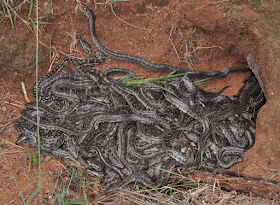 |
| Neonate southern African pythons (Python natalensis) basking at the entrance to the nest chamber.
in Alexander. 2018. DOI: 10.1111/jzo.12554
|
Abstract
Reproductive strategies such as parental care have been pivotal in evolutionary innovations such as endothermy in birds and mammals. The diversity of reproductive biology across the squamates provides a unique opportunity for elucidating the selective forces responsible for the evolution of various reproductive strategies. Here, I report on the reproductive biology of the southern African python (Python natalensis), based on a 7-year study of free-ranging pythons, revealing a behavioural complexity not usually expected for snakes. Mating occurred in the austral winter, with individual males following females for more than 2 months. As is typical for pythons, females brooded eggs by coiling around the clutch. Females are capital breeders; they lost ~40% body mass during a breeding event and did not breed in consecutive years. There was no evidence of the facultative thermogenesis that has been reported in congeners, suggesting that facultative thermogenesis has arisen independently more than once in Python. Reproductive females thermoregulated more carefully than non-reproductives, maintaining higher, more stable Tbs at all stages of reproduction, especially while brooding. This was achieved by a stereotypic basking regime facilitated by ‘facultative melanism’, with females darkening significantly for the entire breeding event. Mothers remained with neonates at the nest site for approximately 2 weeks after hatching. During this time, mothers alternated between brief bouts of basking on the surface and coiling around the hatched eggs, on which the neonates rested. Neonates formed an aggregation near the burrow entrance to bask during the day, individually returning to the nest intermittently throughout the day. During the night, neonates remained within the mother's coils on the hatched eggs. This study highlights the diversity of reproductive biology within Python and cautions against generalization in this regard. This is the first unambiguous report of maternal care of neonates in an oviparous snake.
 |
| Figure 4. Neonate southern African pythons (Python natalensis) basking at the entrance to the nest chamber. Some of the neonates have already undergone their first shed. |
G. J. Alexander. 2018. Reproductive Biology and Maternal Care of Neonates in southern African Python (Python natalensis). Journal of Zoology. DOI: 10.1111/jzo.12554
New insights into how southern African pythons look after their babies theconversation.com/new-insights-into-how-southern-african-pythons-look-after-their-babies-91276
'Cold-blooded' pythons make for caring moms phy.so/440240120 via @physorg_com